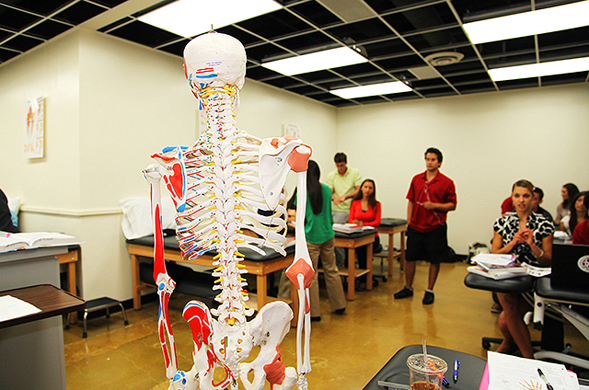Physical Therapy Doctorate Launches
The new doctoral program responds to a country-wide shortage of physical therapists.

San Diego State University’s College of Health and Human Services has launched a Doctor of Physical Therapy Program – the only state supported program of its kind in the county.
While SDSU’s College of Health and Human Services offers a pre-physical therapy concentration in its School of Exercise and Nutritional Sciences, the new DPT program responds to a growing need for physical therapy professionals across the country. The U.S. Bureau of Labor Statistics projects a nearly 40-percent growth in demand for physical therapists by 2020, as compared to 2010.
“The program couldn’t come in a greater time of need,” Marilyn Newhoff, dean of the College of Health and Human Services said. “There is an expanding population of elderly and returning wounded war veterans, among others, who are in need of physical therapists. We are excited to have a program such as this that supports a growing need in the community.”
With its new doctoral program, SDSU is now one of six DPT programs offered by the California State University system. Graduates become licensed physical therapists after passing a national licensure exam and meeting the state licensure requirements. The CSU currently educates one-third of the state's physical therapy graduates.
Practitioners-in-training
The three-year program includes instruction, anatomy coursework, clinical laboratory experiences and clinical clerkships and internships. Presently, SDSU has created partnerships with 50 physical therapy clinical sites offering out-patient and in-patient care, as well as skilled nursing facilities where the students will be interning.
The research component to the DPT program will have faculty and students working to advance the fields of orthopedics, neurology, and other physical therapy areas of practice.
Setting a Standard
The inaugural class of 36 students began their studies in the fall 2012 semester.
“The students are very diverse,” Mitchell J. Rauh, DPT program director, said. “While most were kinesiology or biology majors; some of them have a business background; one of them won American’s Finest Half Marathon this year and another was a former Aztec softball catcher.”
Rauh said the charter class comes with exceptionally high overall academic success too. The class has an overall incoming grade point average of 3.75 and science prerequisite grade point average of 3.7.
Accreditation and Application
The program has been granted Candidate for Accreditation status by the Commission on Accreditation in Physical Therapy Education of the American Physical Therapy Association. The pre-accreditation status of affiliation with the Commission on Accreditation in Physical Therapy Education indicates the program is progressing toward accreditation.
Interested students can find out more information about the requirements for application here.
White Coat Ceremony
SDSU’s first class of Doctor of Physical Therapy students received their professional coats at the program’s inaugural White Coat Ceremony on Oct. 22. Mitchell Rauh, DPT program director, robed the students and Nancy Marlin, SDSU provost, pinned on the students’ official name badges.
The White Coat Ceremony marks the students’ transition from preclinical to clinical studies. The students will wear their coats during their clerkships and internships.
Marilyn Newhoff, dean of the College of Health and Human Services, and Fred Kolkhorst, director and professor in the School of Exercise and Nutritional Sciences, also participated in the ceremony.




